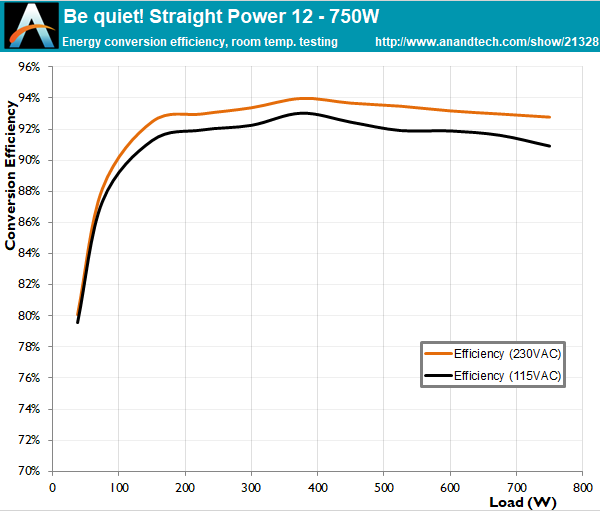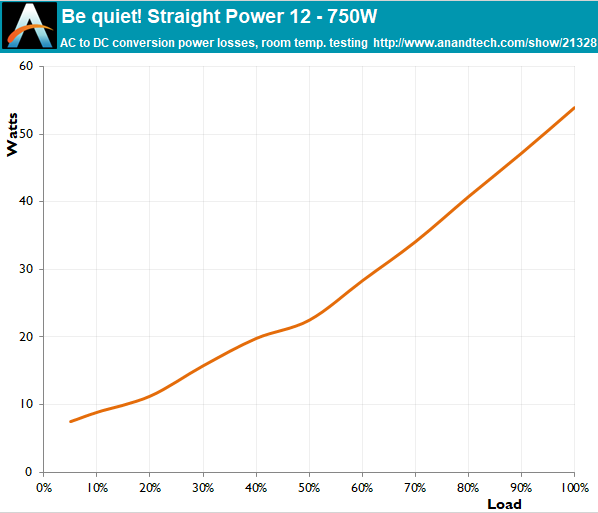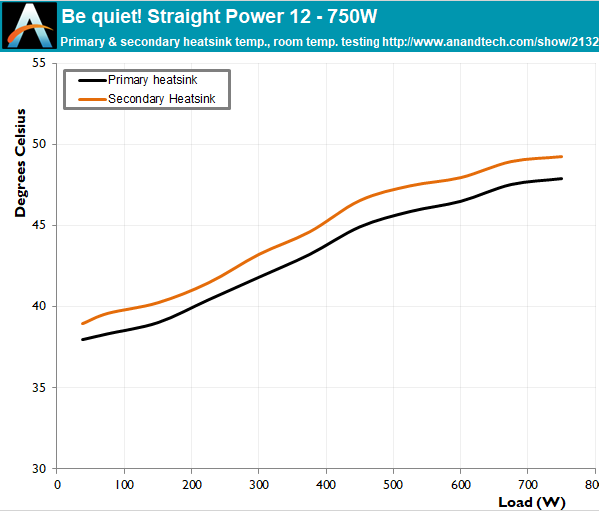The be quiet! Straight Power 12 750W PSU Review: Proficient Platinum Power
by E. Fylladitakis on April 5, 2024 8:00 AM EST- Posted in
- Cases/Cooling/PSUs
- PSUs
- 750W
- be quiet!
- 80Plus Platinum
Cold Test Results (~25°C Ambient Temperature)
For the testing of PSUs, we are using high precision electronic loads with a maximum power draw of 2700 Watts, a Rigol DS5042M 40 MHz oscilloscope, an Extech 380803 power analyzer, two high precision UNI-T UT-325 digital thermometers, an Extech HD600 SPL meter, a self-designed hotbox and various other bits and parts. For a thorough explanation of our testing methodology and more details on our equipment, please refer to our How We Test PSUs - 2014 Pipeline post.
The Be quiet! Straight Power 12 750W meets and surpasses the 80Plus Platinum certification standards, showcasing exceptional electrical conversion efficiency. With a 115 VAC input, this unit delivers an average nominal load range efficiency (covering 20% to 100% of its capacity) of 91.9%, and an impressive 93.2% efficiency when powered by a 230 VAC source. Like most manufacturers, be quiet! received the certification rating with an input voltage of 115 VAC, where the requirements are lower – however, the 750W version of the Straight Power 12 also meets the 80Plus Platinum certification requirements with an input voltage of 230 VAC.
The Be quiet! Straight Power 12 750W PSU doesn't feature a "hybrid" fan mode, which means its fan is active from the start. Thanks to its design, the fan operates at a very low speed even when the load reaches up to 50%, ensuring that the unit runs quietly under typical conditions. As the load increases, the fan's speed increment is modest, designed to keep noise levels down. Despite this conservative approach to fan speed, the thermal control circuitry manages to keep internal temperatures surprisingly low, even at full load. This indicates high energy conversion efficiency paired with a somewhat oversized cooling system, designed to be capable of achieving top performance at minimal noise levels.















32 Comments
View All Comments
ballsystemlord - Wednesday, April 10, 2024 - link
I'll take you up on that. What exactly is holding AT back from being the most popular tech site on the Internet with the best scientific takes on all the HW that gets reviewed?PS: I did try to PM you in the forum, but that function appears to not be implemented and I don't have an email for you. Reply
Ryan Smith - Wednesday, April 10, 2024 - link
My email address is listed on my author page. Replyballsystemlord - Wednesday, April 10, 2024 - link
@Ryan , Going to the "about" page, we find a link: http://www.anandtech.com/Author/85 for you. Clicking it we get a list of articles you authored, no info about you is present.Maybe you could give me a hint as to where to find your author page? Reply
Ryan Smith - Thursday, April 11, 2024 - link
The link on my author page is titled "Email Ryan Smith" Replyballsystemlord - Friday, April 12, 2024 - link
I found it and sent an email. Replyballsystemlord - Tuesday, April 16, 2024 - link
Not to be a pest, but maybe you could respond to my email? Or did you not receive it? It's been 5 days. ReplyGeoffreyA - Wednesday, April 10, 2024 - link
Agreed. I think we all want to see AT back at the top, where it belongs. Threadbare, lesser sites are doing so well. Replyballsystemlord - Tuesday, April 9, 2024 - link
The comment section isn't what draws views. The content is. Or so I would think. Replywrkingclass_hero - Tuesday, April 16, 2024 - link
Let's be honest, Ryan just stopped reviewing GPUs. It was not like they weren't getting sent, the reviews just didn't come out. After like a year of delayed reviews, there was a fire which destroyed whatever work was or was not done on those missing reviews. It's understandable why GPUs would no longer be sent by manufacturers or purchased by the publisher.It's not like E. Fylladitakis is in a position to change the present fate or future direction of Anandtech, he's nobly continuing to produce the kind of articles that he always has. Reply
Oxford Guy - Monday, April 8, 2024 - link
'Despite this conservative approach to fan speed, the thermal control circuitry manages to keep internal temperatures surprisingly low, even at full load. This indicates high energy conversion efficiency paired with a somewhat oversized cooling system, designed to be capable of achieving top performance at minimal noise levels.'In other words, correct PSU design. Reply